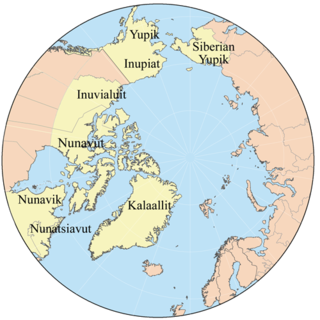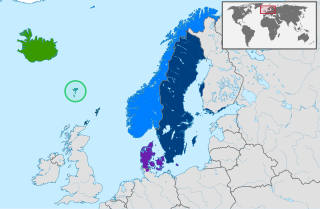
Danish is a North Germanic language spoken by about six million people, principally in and around Denmark. Communities of Danish speakers are also found in Greenland, the Faroe Islands, and the northern German region of Southern Schleswig, where it has minority language status. Minor Danish-speaking communities are also found in Norway, Sweden, the United States, Canada, Brazil, and Argentina.

Eskimo is an exonym used to refer to two closely related Indigenous peoples: the Inuit and the Yupik of eastern Siberia and Alaska. A related third group, the Aleut, which inhabit the Aleutian Islands, are generally excluded from the definition of Eskimo. The three groups share a relatively recent common ancestor, and speak related languages belonging to the Eskaleut language family.

Greenland is an island country in North America that is part of the Kingdom of Denmark. It lies between the Arctic and Atlantic oceans, east of the Canadian Arctic Archipelago. Greenland is the world's largest island. It is one of three countries that form the Kingdom of Denmark, the others being Denmark and the Faroe Islands; the citizens of all these countries are citizens of Denmark and of the European Union. The capital of Greenland is Nuuk.

This is a demography of the population of Greenland including population density, ethnicity, economic status, religious affiliations and other aspects of the population.

The Inuit languages are a closely related group of indigenous American languages traditionally spoken across the North American Arctic and the adjacent subarctic regions as far south as Labrador. The Inuit languages are one of the two branches of the Eskimoan language family, the other being the Yupik languages, which are spoken in Alaska and the Russian Far East. Most Inuit people live in one of three countries: Greenland, a self-governing territory within the Kingdom of Denmark; Canada, specifically in Nunavut, the Inuvialuit Settlement Region of the Northwest Territories, the Nunavik region of Quebec, and the Nunatsiavut and NunatuKavut regions of Labrador; and the United States, specifically in northern and western Alaska.

Scandinavia is a subregion in Northern Europe, with strong historical, cultural, and linguistic ties between its constituent peoples. Scandinavia most commonly refers to Denmark, Norway, and Sweden. In English usage, it can sometimes also refer more narrowly to the Scandinavian Peninsula, or more broadly to all of the Nordic countries, also including Finland, Iceland, and the Faroe Islands.

The history of Greenland is a history of life under extreme Arctic conditions: currently, an ice sheet covers about eighty percent of the island, restricting human activity largely to the coasts.

The North Germanic languages make up one of the three branches of the Germanic languages—a sub-family of the Indo-European languages—along with the West Germanic languages and the extinct East Germanic languages. The language group is also referred to as the Nordic languages, a direct translation of the most common term used among Danish, Faroese, Icelandic, Norwegian, and Swedish scholars and people.

The Inatsisartut, also known as the Parliament of Greenland in English, is the unicameral parliament of Greenland, an autonomous territory in the Danish realm. Established in 1979, it meets in Inatsisartut, on the islet of Nuuk Center in central Nuuk.

Greenlandic is an Eskimo–Aleut language with about 57,000 speakers, mostly Greenlandic Inuit in Greenland. It is closely related to the Inuit languages in Canada such as Inuktitut. It is the most widely spoken Eskimo–Aleut language.

Swedish is the official language of Sweden and is spoken by the vast majority of the 10.23 million inhabitants of the country. It is a North Germanic language and quite similar to its sister Scandinavian languages, Danish and Norwegian, with which it maintains partial mutual intelligibility and forms a dialect continuum. A number of regional Swedish dialects are spoken across the country. In total, more than 200 languages are estimated to be spoken across the country, including regional languages, indigenous Sámi languages, and immigrant languages.

The Kingdom of Denmark has only one official language, Danish, the national language of the Danish people, but there are several minority languages spoken, namely Faroese, German, and Greenlandic.

Inuktun is the language of approximately 1,000 indigenous Inughuit, inhabiting the world's northernmost settlements in Qaanaaq and the surrounding villages in northwestern Greenland.

The Danish Realm, officially the Kingdom of Denmark, is a sovereign state located in Northern Europe and Northern North America. It consists of metropolitan Denmark—the kingdom's territory in continental Europe and sometimes called "Denmark proper" —and the realm's two autonomous regions: the Faroe Islands and Greenland. The relationship between the three parts of the Kingdom is also known as The unity of the Realm.
A non-binding referendum on Greenland's autonomy was held on 25 November 2008 to support or oppose the Greenland Self-Government Act. It was passed with 75% approval and a 72% turnout. The non-binding referendum was on expanded home rule in 30 areas, including police, courts, and the coast guard; gave Greenland a say in foreign policy; provided a more definite split of future oil revenue; and made the Greenlandic language the sole official language.

Greenlandic Norse is an extinct North Germanic language that was spoken in the Norse settlements of Greenland until their demise in the late 15th century. The language is primarily attested by runic inscriptions found in Greenland. The limited inscriptional evidence shows some innovations, including the use of initial t for þ, but also the conservation of certain features that changed in other Norse languages. Some runic features are regarded as characteristically Greenlandic, and when they are sporadically found outside of Greenland, they may suggest travelling Greenlanders.

Greenlanders are people identified with Greenland or the indigenous people, the Greenlandic Inuit. This connection may be residential, legal, historical, or cultural. For most Greenlanders, many of these connections exist and are collectively the source of their being Greenlandic. However, the term can in different contexts be delimited more precisely in different ways: as the inhabitants of Greenland, as nationals of Greenland or more broadly as persons who feel a cultural affiliation in a broad sense to Greenland. More controversial is a more recent use of the word in the sense persons of Greenlandic origin, i.e. persons whose parents were born in Greenland.

Greenlandic independence is a political ambition of some political parties, advocacy groups, and individuals of Greenland, an autonomous territory within the Kingdom of Denmark, to become an independent sovereign state.
Danish Greenlanders are ethnic Danes residing in Greenland and their descendants.

Greenlandic people in Denmark are residents of Denmark with Greenlandic or Greenlandic Inuit heritage. According to StatBank Greenland, as of 2020, there were 16,780 people born in Greenland living in Denmark, a figure representing almost one third of the population of Greenland. According to a 2007 Danish government report, there were 18,563 Greenlandic people living in Denmark. The exact number is difficult to calculate because of the lack of differentiation between Greenlandic and Danish heritage in Danish government records and also due to the fact that the way in which people identify themselves is not always a reflection of their birthplace. As of 2018, there were 2,507 Greenlanders enrolled in education in Denmark.



















